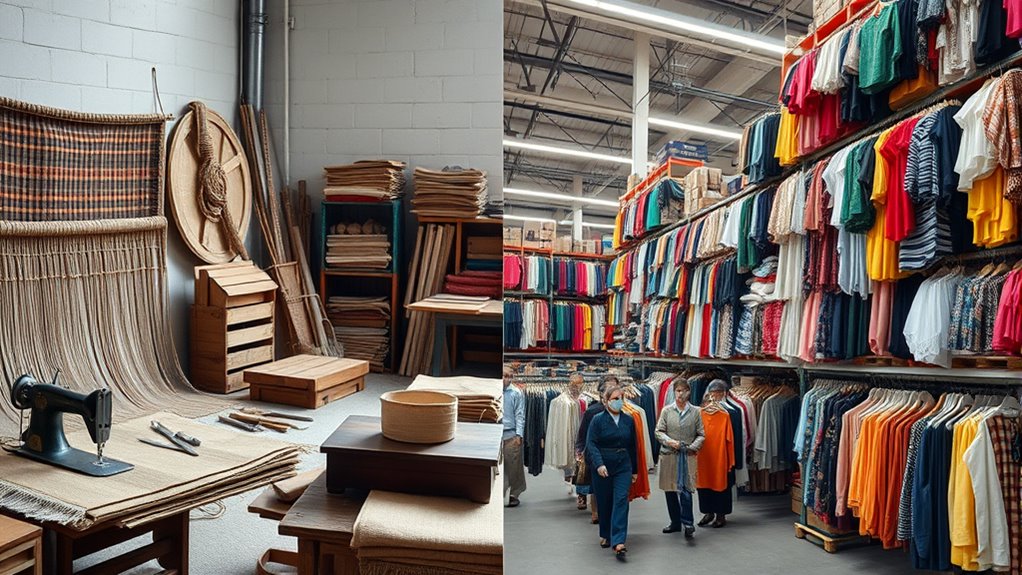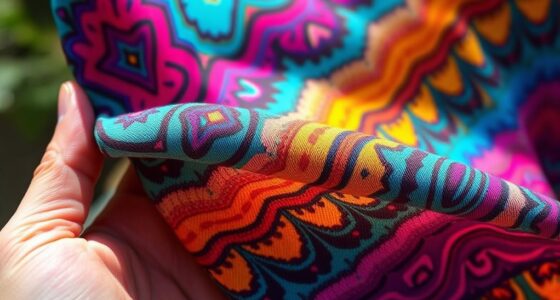Slow fashion emphasizes ethical manufacturing, quality, and sustainability, so you get well-crafted, durable pieces that last longer. It values transparency, fair wages, and eco-friendly practices. Fast fashion, on the other hand, focuses on quick, cheap production, often sacrificing ethics and environmental health. It encourages disposable trends and short-lived items. To understand how choosing one over the other impacts the environment and workers, keep exploring these key differences.
Key Takeaways
- Slow fashion emphasizes quality, sustainability, ethical sourcing, and transparency, while fast fashion prioritizes rapid, low-cost production.
- Slow fashion produces durable, well-crafted items designed to last longer, unlike fast fashion’s quick, disposable garments.
- Ethical practices are central to slow fashion, ensuring fair wages and safe working conditions; fast fashion often involves exploitative labor.
- Slow fashion brands openly share supply chain details, whereas fast fashion supply chains tend to be opaque and less transparent.
- Supporting slow fashion promotes environmental sustainability and fair labor, whereas fast fashion contributes to waste, pollution, and unethical practices.

In recent years, the fashion industry has seen a sharp divide between slow fashion and fast fashion, each offering vastly different approaches to clothing production and consumption. As a consumer, your choices influence not only your wardrobe but also the broader industry practices. Slow fashion emphasizes quality, sustainability, and ethical manufacturing, often prioritizing supply chain transparency. When you opt for slow fashion brands, you’re choosing companies that openly share details about where and how their garments are made. This transparency builds trust, allowing you to see that workers are paid fair wages and work in safe conditions. Ethical manufacturing is at the core of slow fashion, meaning that every step—from sourcing raw materials to final stitching—adheres to fair labor standards and environmentally responsible practices. You might notice that slow fashion pieces tend to be more durable, crafted with care to last longer, which reduces the need for frequent replacements. This approach challenges the throwaway culture promoted by fast fashion, encouraging you to invest in fewer, better-made items. Additionally, slow fashion often incorporates recycled products, reducing environmental impact and promoting sustainability.
Fast fashion, on the other hand, is all about rapid production and low costs, often at the expense of transparency and ethics. You may find yourself drawn to the affordability and constant new arrivals that fast fashion retailers offer, but behind the scenes, their supply chains are often opaque. Many fast fashion brands lack supply chain transparency, making it difficult to verify whether their garments are produced ethically. This opacity can hide exploitative labor practices, unsafe working conditions, and environmental harm. Fast fashion companies prioritize speed and volume over quality and ethics, churning out trendy designs that appeal to your desire for instant gratification. While the prices seem attractive, these garments are typically made quickly and cheaply, resulting in lower durability and higher environmental impact. The focus on rapid turnover encourages a disposable mindset, leading you to buy more clothes more often, which contributes to waste and pollution.
Your awareness of these differences can help you make more conscious choices. Supporting slow fashion means investing in brands that are transparent about their supply chains and committed to ethical manufacturing. It’s about valuing craftsmanship, sustainability, and the well-being of workers. Conversely, recognizing the pitfalls of fast fashion allows you to question the true cost of affordability and trendiness. By understanding these key differences, you empower yourself to choose clothing that aligns with your values, reducing your environmental footprint and supporting fair labor practices. Your wardrobe becomes a reflection of your commitment to a more ethical and sustainable fashion industry.
Frequently Asked Questions
How Does Cost Impact Consumer Choices Between Slow and Fast Fashion?
Your cost sensitivity influences whether you choose slow or fast fashion. If you’re motivated by affordability, fast fashion appeals because of its low prices and quick turnover. However, if you value quality and sustainability, you might be willing to pay more for slow fashion, even if it’s pricier. Your purchase motivation—saving money or investing in eco-friendly options—directly affects how cost impacts your choices.
What Are the Environmental Impacts of Each Fashion Approach?
Imagine your wardrobe as a garden—fast fashion spreads weeds of textile pollution and drains resources like a thirsty desert. Fast fashion‘s quick turnover fuels environmental harm through excessive waste and resource depletion, choking ecosystems. In contrast, slow fashion acts like a mindful gardener, nurturing sustainability and reducing textile pollution by choosing durable, eco-friendly materials. Your choices shape the planet’s health—opt for slow fashion and help restore nature’s balance.
How Do Labor Practices Differ in Slow Versus Fast Fashion Brands?
You’ll find that slow fashion brands prioritize ethical sourcing and guarantee fair wages for workers, promoting better labor practices. They often work closely with local artisans and factories committed to safe conditions and fair pay. In contrast, fast fashion brands may cut costs through cheaper labor, sometimes neglecting workers’ rights. By choosing slow fashion, you support ethical labor standards, helping improve conditions and promoting sustainability in the industry.
Can Fast Fashion Ever Be Sustainable or Eco-Friendly?
You might think fast fashion can’t be sustainable, but it’s possible with ethical sourcing and material innovation. Brands are starting to adopt eco-friendly fabrics and improve supply chain transparency, making quick trends more environmentally responsible. While it’s challenging to match slow fashion’s impact, conscious consumers can push for reforms. By supporting brands committed to sustainability, you help shape a future where fast fashion can be more eco-friendly and ethically sound.
What Role Does Technology Play in Advancing Slow Fashion?
Technology plays a crucial role in advancing slow fashion by enabling sustainable innovation and digital craftsmanship. You can leverage digital tools to design with less waste, source eco-friendly materials more efficiently, and produce high-quality garments with precision. These innovations help you create timeless pieces, reduce environmental impact, and promote ethical practices. Embracing technology allows you to support a more sustainable fashion industry, aligning your values with responsible production and consumption.
Conclusion
In the battle between slow and fast fashion, it’s clear that choosing slow fashion isn’t just a trend—it’s a revolution your wardrobe desperately needs. By supporting ethical brands, you’re not only saving the planet but also making a statement that your style matters more than fleeting trends. Don’t let fast fashion drain your soul or fill landfills with regret. Choose consciously, wear proudly, and be the change the world desperately craves—your choices can change everything.










